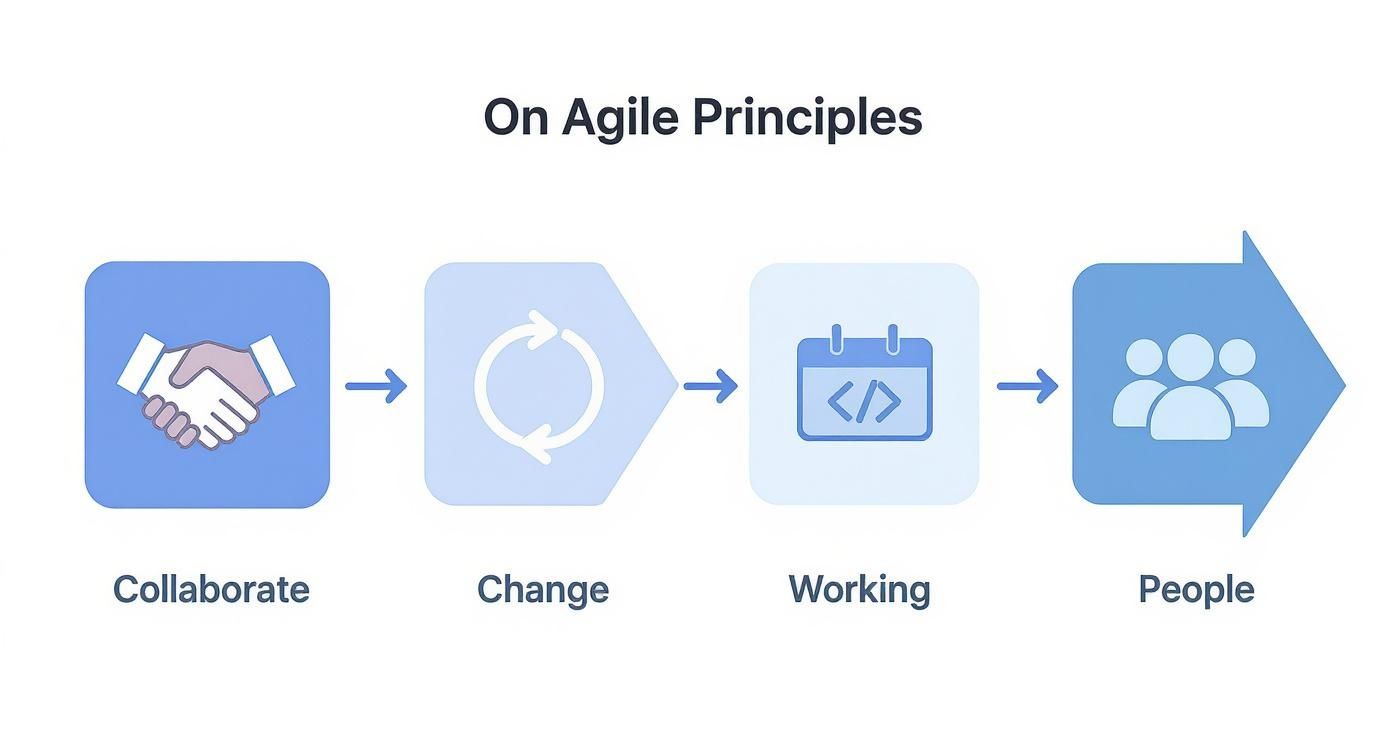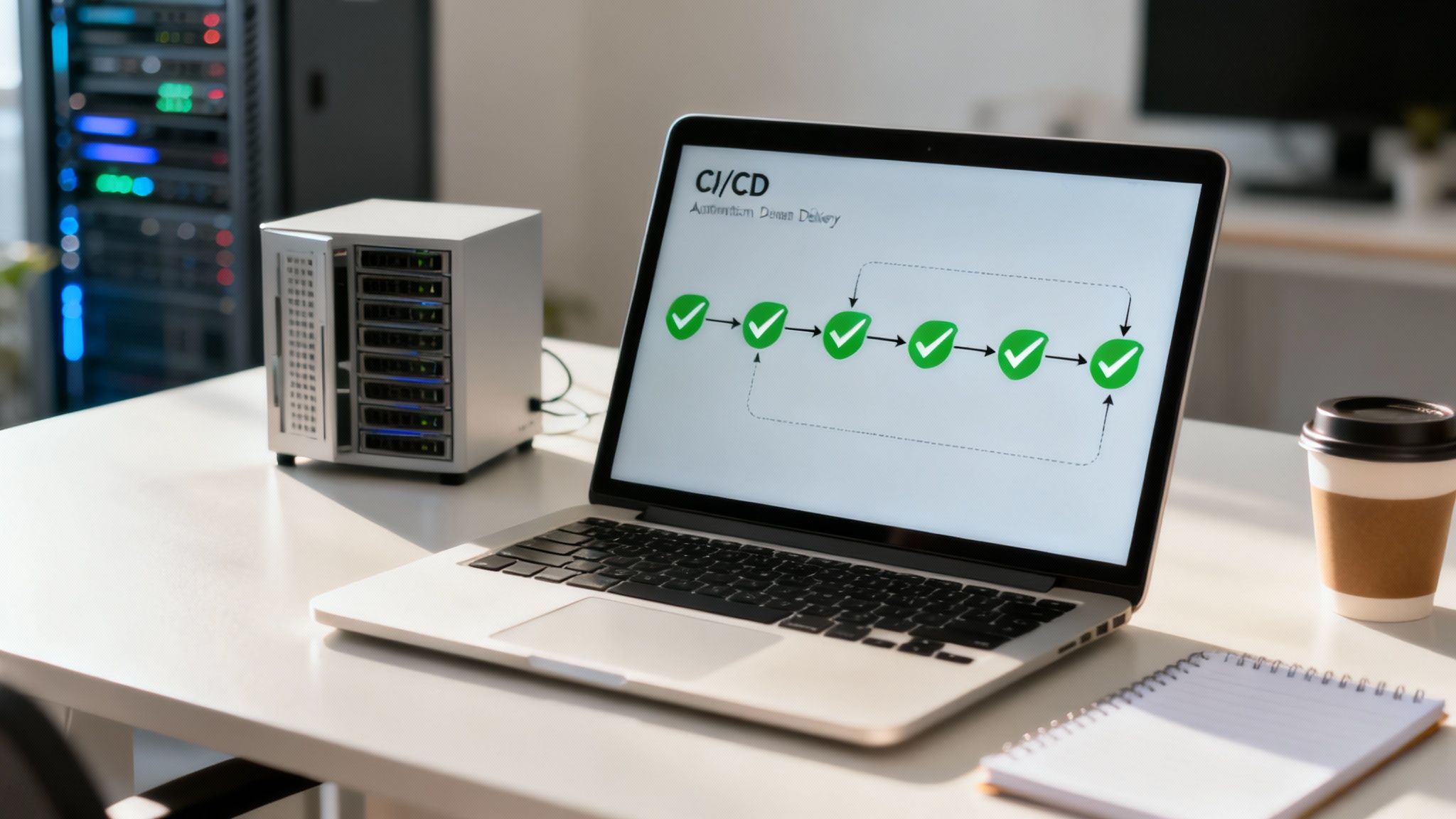The Agile SDLC is a fundamental mindset shift in how modern software is built. It prioritizes flexibility, speed, and continuous alignment with customer needs. Unlike traditional development, where a massive plan is locked in upfront, Agile breaks work into small, manageable cycles called sprints. This iterative approach gets working software into users’ hands faster and, crucially, enables teams to react to change without derailing the entire project.
This guide provides an expert breakdown of the agile methodology in the software development lifecycle, focusing on its business impact and practical implementation for enterprise, SaaS, and technology companies.
What Is the Agile SDLC?
The Agile Software Development Lifecycle (SDLC) is a complete departure from the rigid, sequential project management of the past. Consider the traditional approach, often called the Waterfall model, like building a car from a single, unchangeable blueprint. The entire process—design, engineering, assembly—is completed before the customer sees the final product, often years later.
The agile methodology SDLC flips that script entirely.
Using Agile, the team focuses on delivering a functional chassis and engine first—a core product you can test. In the next sprint, they add the body panels. Then the interior. At every stage, stakeholders provide real-world feedback, allowing for immediate adjustments. This iterative, hands-on process has made Agile the go-to model for leading SaaS, finance, and tech companies seeking a competitive edge.
Driving Business Value Through Iteration
The core purpose of the Agile SDLC is to accelerate time-to-market, slash development risk, and build a product that customers genuinely need. Instead of a single, high-stakes “big bang” launch, Agile delivers value incrementally, providing significant business advantages:
- Faster ROI: Release core features early and often to start generating revenue or gathering user data much sooner.
- Reduced Risk: Identify and resolve issues continuously with frequent testing and stakeholder feedback, preventing costly flaws from emerging late in the cycle.
- Enhanced Adaptability: Pivot quickly when customer needs or market conditions change, ensuring the final product remains relevant and competitive.
- Improved Product Quality: Integrate quality assurance into every step of the development cycle, resulting in more robust and reliable software.
This isn’t just theory; the data confirms its impact. A remarkable 71% of companies now use Agile practices. More importantly, 98% of businesses that adopt it report tangible success, with some organizations seeing a 60% increase in revenue—highlighting its direct bottom-line impact.
We have applied these principles to drive measurable outcomes for our clients. Explore our case studies to see how we leverage agile development to achieve client success.
The Core Principles Driving Agile Success
To master the agile methodology SDLC, you must understand the mindset behind it. The Agile Manifesto, the foundational document for this approach, outlines four core values and twelve supporting principles. These values represent a significant shift from rigid, traditional processes toward what delivers real business value.
Let’s examine two principles that directly impact business outcomes.
Customer Collaboration Over Contract Negotiation
Traditional projects often begin by locking the client and development team into a massive, rigid contract before any work begins. Agile flips this on its head by integrating the customer directly into the development process. This constant feedback loop is a powerful strategic advantage.
For example, a SaaS company building a new analytics dashboard can use an Agile approach to deliver a basic, functional version to key users immediately. If user feedback reveals that the initial assumptions about critical metrics were wrong, the team can pivot in the very next sprint. This simple shift saves thousands in development costs that would have been wasted on an unwanted feature and ensures the final product solves real problems, boosting user adoption.
By valuing customer collaboration, Agile transforms development into a strategic partnership. The goal isn’t just to fulfill a contract; it’s to work together to discover the best solution and deliver maximum business impact. Our AI integration services are built on this collaborative foundation.
Responding to Change Over Following a Plan
In today’s fast-moving markets, a six-month-old project plan is often obsolete. The agile SDLC is designed to treat change as an opportunity, not a roadblock. Planning remains essential, but Agile plans are flexible and continuously updated.
Imagine a fintech company developing a mobile banking app when a new regulatory compliance standard is announced. In a Waterfall project, this would be a disaster, likely forcing a full project reset and causing massive delays. An Agile team, however, adapts seamlessly. The Product Owner adds the new compliance requirements as user stories to the backlog for an upcoming sprint. Because the team works in short cycles, they can integrate, test, and validate these new requirements without disrupting the entire project. This adaptability is critical for navigating uncertainty and maintaining a competitive advantage.
How Agile Phases Reshape the Traditional SDLC
Organizations transitioning from traditional models often wonder what happens to the familiar SDLC stages—requirements, design, build, and test. Agile doesn’t eliminate them; it reframes them from a rigid sequence into a tight, concurrent loop executed within every sprint.
The old Waterfall SDLC is like a linear assembly line; you must complete one phase entirely before moving to the next. Agile is more like a spiral staircase. With each turn, you complete a full 360-degree rotation through planning, designing, coding, and testing, delivering a more complete piece of the product with each cycle.
The Anatomy of an Agile Sprint
The sprint is the heartbeat of the Agile SDLC. It’s a short, time-boxed period, typically two weeks, where all traditional SDLC activities occur concurrently, focused on a small batch of high-priority features.
- Requirements & Design: The cycle begins with Sprint Planning, where the team selects user stories from the product backlog. They immediately refine requirements and map out a technical approach. This is not a final, exhaustive design document but a flexible plan that evolves during the sprint.
- Development & Integration: Developers write code for these stories immediately and integrate their work into the main codebase continuously—often multiple times a day. This practice, known as continuous integration, prevents the last-minute merge conflicts that plague Waterfall projects.
- Concurrent Testing & QA: Testing begins on day one. QA professionals work alongside developers, providing instant feedback. Automated tests run continuously, ensuring new features don’t break existing functionality.
This workflow is built on collaboration, adaptability, working software, and empowered teams—the Agile mindset in action.

These principles create a dynamic flow that transforms isolated tasks into a cohesive, value-driven development engine.
Delivering Value Every Cycle
By the end of the sprint, the team produces a potentially shippable increment of software. This means the features are fully designed, coded, tested, and integrated. They actually work. This finished product is demonstrated to stakeholders during the Sprint Review, where immediate feedback informs the next sprint’s priorities.
Reshaping the SDLC isn’t just about speed; it’s about establishing a sustainable rhythm for delivering tangible business value. Each sprint de-risks the project by validating assumptions and ensuring the product meets business needs.
To accelerate these cycles, many teams now use low-code development platforms that fit perfectly into this iterative model. This continuous loop of building, measuring, and learning is what makes the agile methodology SDLC so powerful.
Key Roles and Ceremonies in an Agile SDLC
A successful Agile process is built on a clear structure of roles and ceremonies (events). This framework ensures momentum, transparency, and a relentless focus on delivering value. Without it, teams can easily lose their rhythm and fall out of sync.
The Core Agile Team Roles
At the heart of any high-performing Agile team are three core roles, each with distinct responsibilities to ensure clear ownership from vision to execution.
1. The Product Owner (The Visionary)
The Product Owner is the voice of the customer and the business. They own and prioritize the Product Backlog—the master to-do list for the entire product—to ensure the team is always building the right thing at the right time to maximize business value.
2. The Scrum Master (The Coach)
The Scrum Master is a servant-leader, not a traditional project manager. They facilitate Agile principles, remove roadblocks, and coach the team toward self-organization and high performance. Their goal is to empower a team that can solve problems and deliver consistently without micromanagement.
3. The Development Team (The Builders)
This is the cross-functional group of engineers, designers, QA analysts, and other specialists who turn backlog items into working software. They are self-organizing, determining how to best accomplish the work. Their collective focus is on shipping a high-quality product increment every sprint.
A deep dive into a modern Agile team structure can help you scale these concepts effectively as your organization grows.
The Essential Agile Ceremonies
Agile ceremonies give the process its pulse. These are not just meetings; they are structured, time-boxed events designed to inspect work and adapt the plan.
These events are the heartbeat of an Agile sprint. Each serves a specific purpose to minimize the need for other, less productive meetings while ensuring everyone stays aligned and focused on the sprint goal.
- Sprint Planning: At the start of each sprint, the team collaborates to define a Sprint Goal and select the work they can realistically deliver from the backlog.
- Daily Stand-up (Daily Scrum): A quick, 15-minute daily sync for the Development Team to align on progress, upcoming work, and any impediments. It is a peer-to-peer commitment, not a status report for management.
- Sprint Review: At the sprint’s end, the team demonstrates the working software to stakeholders. This hands-on session generates crucial feedback to guide future development.
- Sprint Retrospective: The final meeting of the sprint, where the team reflects on its process. They discuss what went well, what could be improved, and commit to one or two process improvements for the next sprint. This is the engine of continuous improvement.
Implementing Agile with DevOps and CI/CD
Adopting the agile methodology SDLC is just the first step. To achieve true agility and accelerate value delivery, you must pair it with a strong DevOps culture and robust CI/CD (Continuous Integration/Continuous Delivery) pipelines. This combination transforms your development process from a series of manual handoffs into a smooth, automated workflow.
DevOps breaks down the silos between Development (Dev) and Operations (Ops) teams, fostering a culture of shared ownership and collaboration. Teams work together across the entire lifecycle, from the first line of code to production deployment.

This synergy is driving major organizational shifts. Engineering and R&D teams are now the fastest-growing group of Agile adopters, making up 48% of all practitioners—a 16% increase from 2022. This trend, highlighted in the 17th Annual State of Agile Report, shows how technical and product organizations are fundamentally restructuring their work.
Building the Automation Engine with CI/CD
If DevOps is the culture, CI/CD is the automation engine that powers it. It automates the process of building, testing, and deploying code, eliminating bottlenecks and enabling frequent, reliable software releases.
- Continuous Integration (CI): Developers merge code changes into a central repository multiple times a day. Each merge triggers an automated build and test sequence, catching integration bugs almost immediately.
- Continuous Delivery/Deployment (CD): Once CI tests pass, the code is automatically deployed to a testing environment (Continuous Delivery). For mature teams, it can even be deployed directly to production (Continuous Deployment), allowing new features to reach users in minutes.
A well-architected CI/CD pipeline is a competitive advantage. You can see these principles in action in our successful CI/CD case studies.
Shifting Left for Security and Compliance
A common mistake is leaving security and compliance checks until the end of the development cycle. The “Shift Left” principle integrates these critical steps into the CI/CD pipeline from day one. Automated security scans and policy checks run with every code commit, rather than during a frantic, last-minute review.
For regulated industries like finance, government, or healthcare, this is non-negotiable. Building security into every sprint makes the entire process safer and ensures the final product is secure by design.
By integrating security and compliance into the automated workflow, teams move faster without sacrificing quality or taking on unnecessary risk. This makes agility sustainable, especially in highly regulated environments.
Measuring What Matters Most
To validate your Agile transformation, you must measure the flow of value. Focus on metrics that reveal the health and efficiency of your process.
- Cycle Time: The time it takes for a task to move from “in progress” to “done.” This measures the efficiency of your development process.
- Lead Time: The total time from when a request is made until it is delivered to the customer. This measures your entire value stream, from idea to impact.
Tracking these metrics helps identify bottlenecks and provides objective data for Sprint Retrospectives, enabling a data-driven approach to continuous improvement.
How to Scale Agile for Enterprise Teams
What works for a single team can break down when coordinating the work of dozens. Scaling the agile methodology sdlc across a large enterprise, especially with distributed teams, introduces new complexities like managing cross-team dependencies and maintaining strategic alignment. To address this, organizations turn to specialized frameworks designed for agility at scale.
Choosing Your Scaling Framework: SAFe vs. LeSS
Two prominent scaling frameworks are the Scaled Agile Framework (SAFe) and Large-Scale Scrum (LeSS). They solve the same problem from different angles, and the right choice depends on your organization’s structure and goals.
- Scaled Agile Framework (SAFe): SAFe is a highly structured, prescriptive framework ideal for large, complex enterprises in regulated industries like finance or government. It provides clear roles, processes, and a hierarchy to align numerous teams with strategic business goals, emphasizing predictability and detailed planning.
- Large-Scale Scrum (LeSS): LeSS is a more minimalist framework that extends core Scrum principles to multiple teams. It is far less prescriptive than SAFe, empowering teams and maintaining a simple organizational structure. LeSS is often a better fit for product-centric companies that prioritize nimbleness and want to avoid excessive process overhead.
The adoption of these frameworks is accelerating. Global SAFe usage is projected to hit 53% by 2025, a 43% increase from 2021. With 61% of companies having used Agile for over five years, the market is clearly seeking mature scaling solutions. You can find more insights on the latest state of Agile adoption.
Practical Strategies for Scaling Success
Regardless of the framework, success hinges on excellent communication and collaboration, especially with remote or offshore teams. Structuring a dedicated development team model effectively is a crucial first step for companies looking to expand their talent pool.
Scaling Agile isn’t just “doing more Agile.” It’s about designing a system where multiple teams can deliver value together, seamlessly. This requires a deliberate focus on communication, alignment, and the right tools.
Technology is a key enabler. Enterprise Agile Planning tools like Jira Align provide portfolio-level visibility, connecting high-level strategy to individual team execution. Digital collaboration platforms like Miro become virtual planning rooms, ensuring distributed teams can brainstorm and align as if they were in the same location.
By combining the right framework with powerful tools, you can elevate Agile from a team-level practice to a true enterprise-wide capability.
A Few Common Agile SDLC Questions
When first exploring the Agile SDLC, several common questions arise. Clarifying these points helps bridge the gap between theory and practical application.
What Is the Difference Between Agile and Scrum?
This is the most frequent question. The simplest way to understand the distinction is: Agile is the philosophy, while Scrum is a framework for implementing that philosophy. Agile is the overarching mindset that values iteration, customer feedback, and adaptability.
Scrum provides the specific roles, ceremonies, and artifacts to put the Agile philosophy into practice.
- Agile: The “why” and “what.” It’s a core value, such as “we prioritize working software over comprehensive documentation.”
- Scrum: The “how.” It’s the playbook, such as “we will use two-week sprints, daily stand-ups, and a product backlog to build that software.”
While Scrum is the most popular way to implement Agile, other frameworks like Kanban also provide effective ways to achieve agility.
How Does Agile Handle Fixed Budgets and Deadlines?
This is a critical concern for any business requiring predictability. Unlike Waterfall, where scope is fixed, Agile fixes time and cost. With a firm deadline and budget, an Agile team ruthlessly prioritizes features based on business value.
An Agile team working with fixed constraints guarantees that a functional, high-quality product will be delivered within those constraints. What flexes is the scope. The team ships the most critical features first, ensuring a viable product is delivered even if lower-priority items are deferred.
This approach is a powerful defense against project failure. It ensures the highest-value work is completed and delivered, preventing the outcome of a half-finished product that provides no value at all.
Is Adopting Agile a One-Time Project?
Absolutely not. A common pitfall is treating Agile adoption as a project with a defined start and end date. In reality, it is an ongoing journey of continuous improvement.
Your first sprint will not be perfect, and that is by design. The entire methodology is built on learning and adapting. Ceremonies like the Sprint Retrospective are specifically designed to help your team pause, reflect, and identify ways to make the next sprint more effective than the last. This commitment to continuous improvement is the essence of becoming truly Agile.
Ready to implement a high-performing Agile process with a team that delivers results? Group 107 provides dedicated offshore software development teams that integrate seamlessly with your organization, helping you accelerate delivery and scale with confidence. Build your expert team today.




